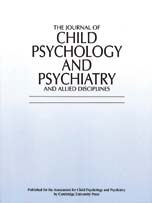Crossref Citations
This article has been cited by the following publications. This list is generated based on data provided by
Crossref.
OʼHara, Jean
1999.
Advances in psychotherapy in learning disability.
Current Opinion in Psychiatry,
Vol. 12,
Issue. 5,
p.
555.
Leevers, Hilary J.
and
Harris, Paul L.
2000.
Counterfactual Syllogistic Reasoning in Normal 4-Year-Olds, Children with Learning Disabilities, and Children with Autism.
Journal of Experimental Child Psychology,
Vol. 76,
Issue. 1,
p.
64.
Baron-Cohen, Simon
2000.
Autism.
Vol. 23,
Issue. ,
p.
169.
Blanc, R.
Adrien, J. -L.
Roux, S.
and
Barthélémy, C.
2005.
Dysregulation of pretend play and communication development in children with autism.
Autism,
Vol. 9,
Issue. 3,
p.
229.
Garner, Pamela W.
Curenton, Stephanie M.
and
Taylor, Kelli
2005.
Predictors of mental state understanding in preschoolers of varying socioeconomic backgrounds.
International Journal of Behavioral Development,
Vol. 29,
Issue. 4,
p.
271.
Allen, Melissa L.
2009.
Brief Report: Decoding Representations: How Children with Autism Understand Drawings.
Journal of Autism and Developmental Disorders,
Vol. 39,
Issue. 3,
p.
539.
Subbotsky, Eugene
Hysted, Claire
and
Jones, Nicola
2010.
Watching Films with Magical Content Facilitates Creativity in Children.
Perceptual and Motor Skills,
Vol. 111,
Issue. 1,
p.
261.
Pring, Linda
Ryder, Nicola
Crane, Laura
and
Hermelin, Beate
2012.
Creativity in savant artists with autism.
Autism,
Vol. 16,
Issue. 1,
p.
45.
Ten Eycke, Kayla D.
and
Müller, Ulrich
2015.
Brief Report: New Evidence for a Social-Specific Imagination Deficit in Children with Autism Spectrum Disorder.
Journal of Autism and Developmental Disorders,
Vol. 45,
Issue. 1,
p.
213.
Allen, Melissa L.
and
Craig, Eleanore
2016.
Brief Report: Imaginative Drawing in Children with Autism Spectrum Disorder and Learning Disabilities.
Journal of Autism and Developmental Disorders,
Vol. 46,
Issue. 2,
p.
704.
Weiskopf, Daniel A.
2017.
An ideal disorder? Autism as a psychiatric kind.
Philosophical Explorations,
Vol. 20,
Issue. 2,
p.
175.
Ten Eycke, Kayla D
and
Müller, Ulrich
2018.
Drawing links between the autism cognitive profile and imagination: Executive function and processing bias in imaginative drawings by children with and without autism.
Autism,
Vol. 22,
Issue. 2,
p.
149.
SARI, Oktay Taymaz
2019.
Otistik Çocuklarda Hayali Resim Çizebilme Performansının Otizm Derecesi ve Gelişim Tarama Testleri İle İlişkili Olarak İncelenmesi.
Kastamonu Eğitim Dergisi,
Vol. 27,
Issue. 2,
p.
897.
Harris, Paul L.
2020.
Can Young Children Draw What Does Not Exist?.
Empirical Studies of the Arts,
Vol. 38,
Issue. 1,
p.
71.
Bergmann, Thomas
Camatta, Rosemarie
Birkner, Joana
and
Sappok, Tanja
2021.
Vision, concretism, repetitism. Typical artistic design features in drawings of adults with autism and intellectual disability.
The Arts in Psychotherapy,
Vol. 72,
Issue. ,
p.
101723.
Beals, Katharine
2021.
Book Review: Autism and the myth of the person alone.
Research on Social Work Practice,
Vol. 31,
Issue. 4,
p.
421.
Hewitt, Olivia Mary
Steel, Craig
Hales, Susie A.
Hayden, Nikita
Gundeslioglu, Hatice
Tapp, Katherine
and
Langdon, Peter
2022.
A systematic review and narrative synthesis of mental imagery tasks in people with an intellectual disability: Implications for psychological therapies.
Clinical Psychology Review,
Vol. 96,
Issue. ,
p.
102178.
Mokhtari, Setareh
and
Parchini, Pariya
2024.
The application of drawing tasks in studying cognitive functions in autism: a systematic review.
International Journal of Developmental Disabilities,
Vol. 70,
Issue. 7,
p.
1153.


